One of the most essential parts of a successful internet marketing strategy is content writing. Without high-quality content that speaks to your target audience, it will be difficult to convert leads or build a loyal following. If you can produce great content, your life as a digital marketer becomes a lot easier.
Digital marketing is all about creating content that engages and informs your target audience. Whether you’re a small business owner trying to build a presence online, or an agency looking to promote a brand, writing good content is key.
Table of Contents
What is content writing?
Content Writing is the process of creating and publishing compelling, engaging, and informative written content. This can include everything from blog posts to eBooks to social media content.
It is an essential part of any marketing strategy, as it helps to attract potential customers and build relationships with them.
Writing good content can be challenging, but it is also rewarding in terms of increased traffic or positive reviews from your audience. Make sure that your copy remains fresh by using current trends and techniques, staying true to your brand’s voice & tone, taking feedback into account when you’re planning new pieces, and being proactive about promoting your work on social media outlets like Instagram and Twitter.
If you want to become a great writer, then start by practicing diversity in both the topics you write about as well as the way that you write about them. Write for diverse types of readers – not just people who share your views or opinions!
Content can make or break a business
Content is the lifeblood of any online business, and it is important to produce high-quality content regularly.
In a survey done by SEMRush, it was found that 97% of the respondent companies use content marketing as an important part of their overall growth strategy
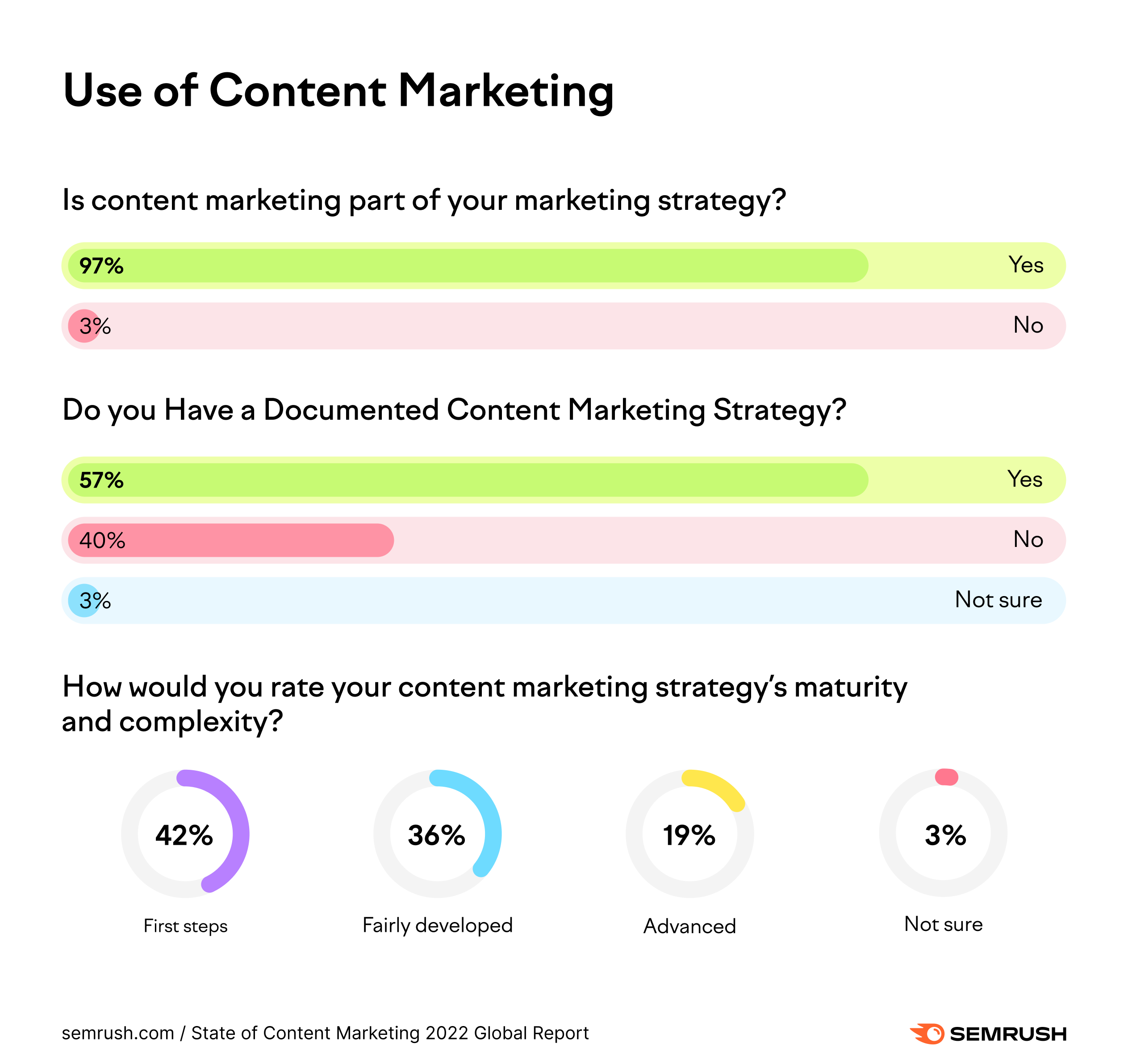
By writing interesting, informative, and engaging content, you can create a following of loyal customers and social media followers. Additionally, content can help you attract new customers, build trust with your current audience, and convert leads into paying customers.
If you’re not writing content that’s relevant to your target audience, then you’re missing this huge opportunity. Without quality content, a website can quickly lose traffic and be forgotten about.
That is why it is essential to make sure you are providing your readers with engaging content regularly. So, make sure to start writing today!
Content is the backbone of every marketing strategy
Writing good copy is paramount in any online business, especially if your plan involves using digital marketing to grow your business. Content needs to be written for blogs, articles, ads, and posts on social media platforms like Facebook or Twitter.

Your social media followers aren’t just there for the sake of browsing pictures; they expect engaging posts that contain blog-style written content, relevant product information, expert tips and tricks on topics related to the brand name/product niche etc. from you.
The cherry on top of the cake is when you post original, unique, and inspiring long-form content like articles and short-form content like social media posts that exceed the readers’ expectations. Then they will eagerly wait for more content from you and will keep visiting your website and social media pages often.
So, to make sure your readers are kept engaged, make sure to share content frequently on social media platforms like Twitter and Facebook. Of course, remember to update your website often, so that your audience is always up to date on your newest news, blog entries, and product launches!
Content is also super important for SEO
Digital content is one of the most important aspects of any digital marketing strategy. It helps to create a positive brand image, attracts and converts leads, and shapes the overall customer experience.
However, there is another important reason for creating content – for ranking well on search engine results pages (SERPs). Always remember that not only humans consume your content – but the search engines do so too!
Writing great content is therefore particularly important for effective Search Engine Optimization. Your website needs powerful content to rank well on search engine results pages (SERPs) of Google, Bing, etc. Without useful content, your website will have no chance of ranking well.
Give relevant content to the search engines, and surely your rankings for important keywords will skyrocket over time.
Content Marketing vs. Content Writing
In the business world, there are two main types of content: marketing content and writing content. Marketing content is used to promote a product or service, while writing content is used to provide information or entertainment. While both types of content are important, they serve different purposes.
Marketing content is typically more sales-oriented and focuses on highlighting the benefits of a product or service. It often includes images, videos, and infographics to grab the reader’s attention.
Content writing, on the other hand, is less promotional and provides more in-depth information about a topic. It’s typically longer than marketing content and includes sources for further reading.
Some businesses use marketing content to drive traffic to their website, while others use writing content to establish themselves as experts in their field.
Copywriting
Copywriting is the process of writing persuasive or informative texts for marketing or advertising purposes. It is all about crafting the right words to persuade your reader to take a specific action.
Copywriting is an essential part of modern marketing, as it helps businesses to create compelling content that can persuade people to buy their products or services. Good copywriting can also help to improve a company’s search engine ranking, as it can help to increase traffic to their website.

Good copywriters can create catchy slogans, headlines, and descriptions that will intrigue potential customers and make them act on the conversion actions that are important for your business.
Copywriting is an essential skill for any content creator and it’s especially important for bloggers. It’s a skill that takes time and practice to master, but it’s well worth the effort.
Copywriting Vs. Content Writing
Copywriting and content writing are two distinct types of writing, but they both have the same goal: to communicate a message to an audience. Copywriting is the process of creating ad copy, or text that is used in marketing materials such as brochures, website pages, and email campaigns. content writing, on the other hand, is the creation of articles, blogs, and other pieces of content that are meant to inform and engage readers.
The main difference between copywriting and content writing is that copywriting is more focused on selling a product or service, while content writing is more focused on providing valuable information to readers.
Copywriters use persuasive language and tactics to get people to buy something, while content writers use their skills to teach people about a topic or persuade them to take a certain action.
Here we will focus on content writing and talk in detail about copywriting in another article.
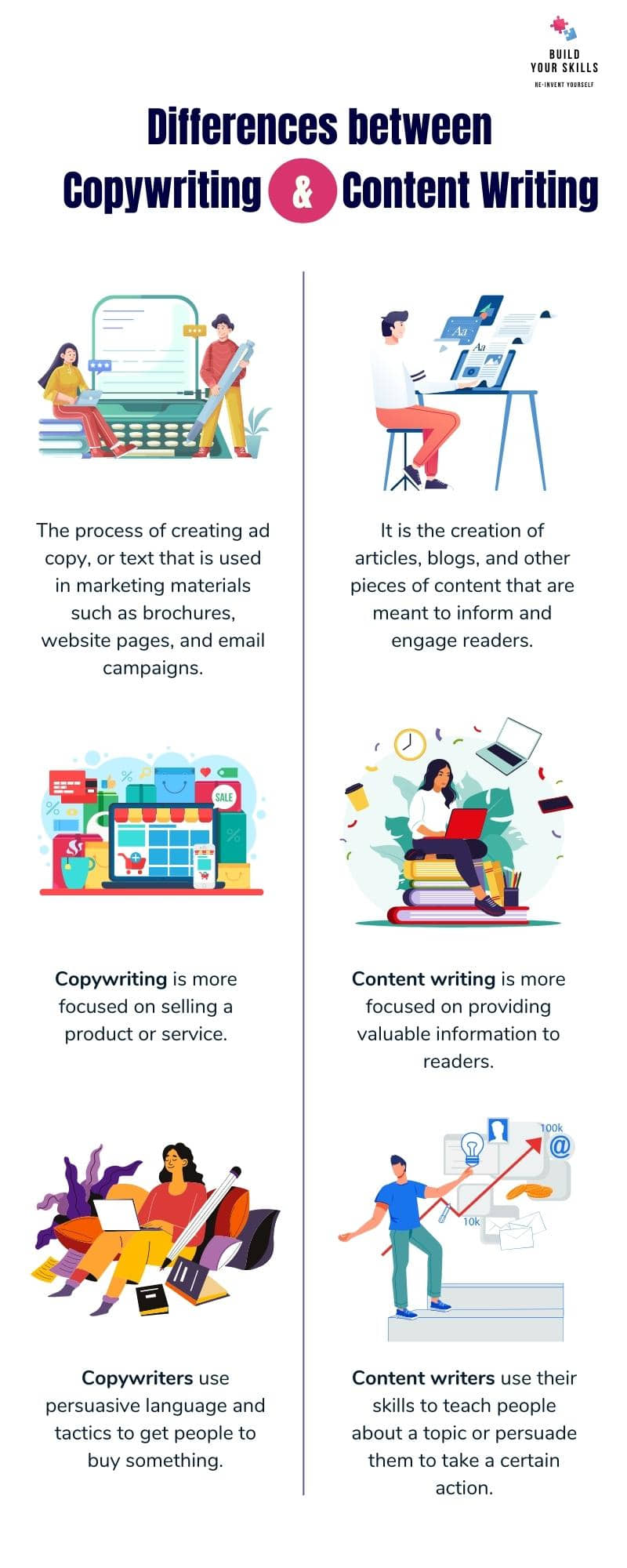
Different Types of Online Content
Online content marketing is an essential strategy for any business looking to reach new people and grow. Incorporating several types of content into your marketing strategy can be a fantastic way to find the right type of content for your audience.
There are many types of content that can be effective in reaching your target market, including informational articles, blog posts, e-books, videos, and infographics. Each type of content has its own purpose and can be used in various ways to reach your target audience.
1. Articles
Writing articles is a great way to share in-depth information with your readers. They can be used to educate or inform your audience about a topic, or to share your opinion on a subject. Articles should be well-written and well-researched and should include sources if possible.
2. Blogs
Blogs can be used to keep your readers up to date on your latest news or thoughts. They can also be used as a platform for promoting your products or services. Blogs should be regularly updated and should include interesting and engaging content that will keep readers coming back for more.
3. Videos
You can create videos to help your target audience learn something new, or to entertain them. Videos can be used as a platform for promoting your products or services, or they can be used in conjunction with articles to give readers more information on a specific topic.

4. Product Descriptions
A product description is a list of all the characteristics of a product. It includes things like the brand, features, features and benefits to the customer, materials used for construction, etc. Product descriptions can be added to your website or blog and will allow readers to learn more about your products.
5. Infographics
Infographics are a great way to visually explain a complex subject, and to promote your company. Infographics can be used on their own as an informative piece, or they can be used with articles to provide more detailed information on a specific topic.
6. eBooks
eBooks are perfect for providing more in-depth, detailed information on a specific topic. eBooks can be used on their own as informative pieces, or they can be used with articles to provide more detailed information on a specific topic. eBooks can be digitally downloaded as HTML, .pdf, .mobi, or .epub file.
7. Guides
A how-to guide is a type of instructional article that provides the reader with detailed instructions on how to do something. How-to guides are often found online, in magazines, or books. They can be used to teach anything from how to make a bed to how to fix a car.
8. Case Studies
Case Studies are approached from a different angle. They are a series of problems that were solved to gain insight into a subject. Case studies are used in business to provide a more detailed and direct look at how one company did something for a client or solved a problem for them. Case studies are also used in business intelligence to provide a detailed report on how one company solved an issue. They can be used to show trends, findings, and other related information.
It is important to choose the right type of content that is most relevant to your audience. By having content created according to the needs of your readers, you will have them remain loyal and keep coming back for more. In this way, you will attract new customers and grow your business!
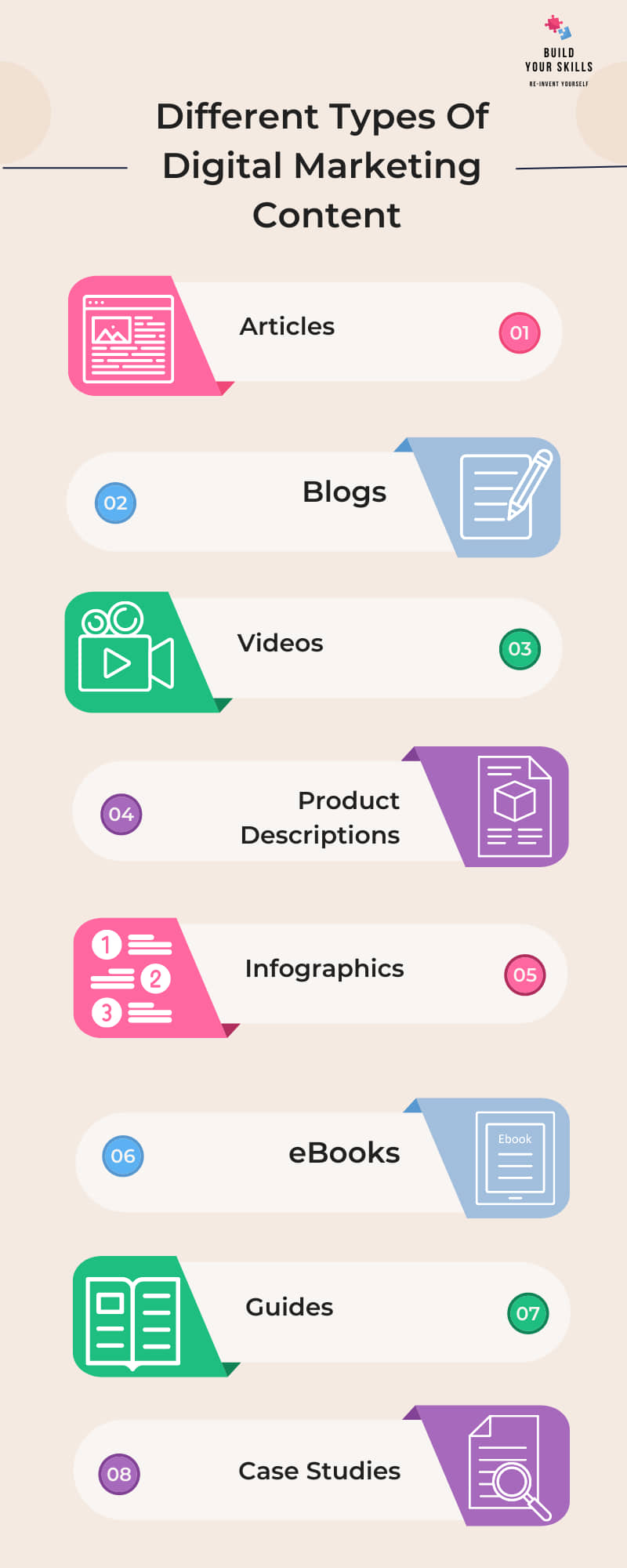
What does a content writer do?
A content writer writes engaging, interesting, and useful content that will help consumers learn something new or have a fun time reading.
They should be skilled in writing for the web, know how to stay up to date on marketing trends and make their writing style to be both fresh and entertaining, take inspiration from experts when it comes to copywriting tips, and use social media platforms like Twitter and Instagram as well as email newsletters to build connections with potential clients.
Content writers need to be adept at delivering punctual results, with timely updates and feedback. They should also be able to keep their content relevant by monitoring trends in various publications and news outlets as they relate to their target market while not making themselves look dated or out of touch.
How to write content effectively?
Your task as a content writer is to provide your readers with valuable information that will solve their problems or help them to achieve their goals.
In this article, we’ll outline the importance of content writing, discuss the several types of content available, and provide tips on how to write great content. We’ll also highlight some copywriting basics and provide rules of writing that apply to all types of online content. So read on and learn everything you need to know about content writing!
Steps for writing great Content
Creating content that is interesting, engaging, and full of information and insights is essential for any blog or website. The best way to achieve this is by starting by brainstorming ideas for your post. Once you have a good list of topics, research the topic to ensure it is relevant and exciting to your audience. Next, research the topic to learn all you can about it. Finally, write in an easy-to-read style that is full of information and insights for your readers. Once your content is ready, test it before releasing it to make sure it’s error-free. Writing good content is a skill that can be learned, and with practice, it will become easier and more enjoyable.
Step 1: Find a topic: what are you interested in writing about?
Writing content for the internet is all about coming up with a topic and then executing the writing process flawlessly. However, it can be hard to find a topic to write about when you don’t know what interests you.
You can start with a rough idea of what you want to say and then start brainstorming some possible topics and angles. Once you have a few ideas, pick the one that best represents your target audience and writing style.
Make sure that the topic or angle you choose is something that you are passionate about because that will show in your writing. The content you write will be clear and concise, while still being interesting and engaging.
As a writer, you will be more interested in writing about topics you are passionate about and will be more likely to write better and faster.
If you are still having trouble finding a topic, try looking online for some inspiration. Do thorough keyword research with AHREFS, SEMRUSH or Google Keyword Planner. You can also explore Google Trends and websites like buzzsumo.com to get loads of ideas about the topics people are consuming.
Step 2: Do your research: find information to support your topic
If you’re like most people, you probably think that creating great content is as simple as sitting down at your computer and putting your thoughts into words. But if you want your content to rank well in search engines and attract readers, you need to do more than that. You need to research your topic thoroughly.
Before starting to write, make sure you have done your research and know everything about your topic. One way to do that is by using a variety of sources, including online tools, journals, newspapers, and books. You can also find useful information by interviewing experts in your field or by conducting surveys. Whatever approach you take, make sure that the information you include is accurate and up to date.
Also, it is a good idea to be transparent with your readers. Let them know where you got your information from and tell them the source of the facts and statistics you have quoted in your article. This will go a long way in building the credibility of your content and will help the readers to trust you more.
Step 3: Create an outline: What will your article look like?
One of the best ways to organize your thoughts and to ensure that your writing is clear and concise is to create an outline. An outline will help you to determine the structure of your article and to make sure that each paragraph covers a single topic. It can also help you to avoid introducing new topics in the middle of your article. In addition, an outline can help you to identify any gaps in your argument or evidence and allow you to fix them before you start writing.
Step 4: Draft the article: Put the words on paper!
The next (and probably the most important) step of writing an article is putting the words on paper. This step can be difficult, especially if you are not used to writing. It is important to take your time and make sure your article is beautifully written.
Whether you’re composing an email, proposal or simply jotting down some thoughts, having a strong command of the English language is key. Hence, look up word meanings, and double-check your spelling and grammar at every step. Nothing kills a good content like bad command over the language you are writing in.
Once the writing is completed, you may want to have someone else read it over to make sure it makes sense.
Step 5: Edit and proofread your articles
No one is perfect, and that includes writers. We all make mistakes, but the key to producing quality content is editing and proofreading your work. You will have to make sure your content is polished properly before it is published.
Make sure you read your article multiple times to catch any errors. We strongly recommend that you ask someone else to proofread it as well.
Typos, incorrect grammar, and factual errors can be easily missed, but they can ruin an article’s credibility. So, take the time to edit and proofread your work – it will make an enormous difference in the final product.
Step 6: Publish your content: Ready to share your work with the world?
Publishing your work can be a scary process, but it’s also an incredibly rewarding one. Once you have completed all the steps mentioned here, go ahead, and publish the content for the world to read. Also, do not forget to share it on social media networks and with your friends and network. You have worked hard to create a piece of content that is worth sharing.
Get it in front of as many people as possible, get their feedback and use those while writing better content in the future.
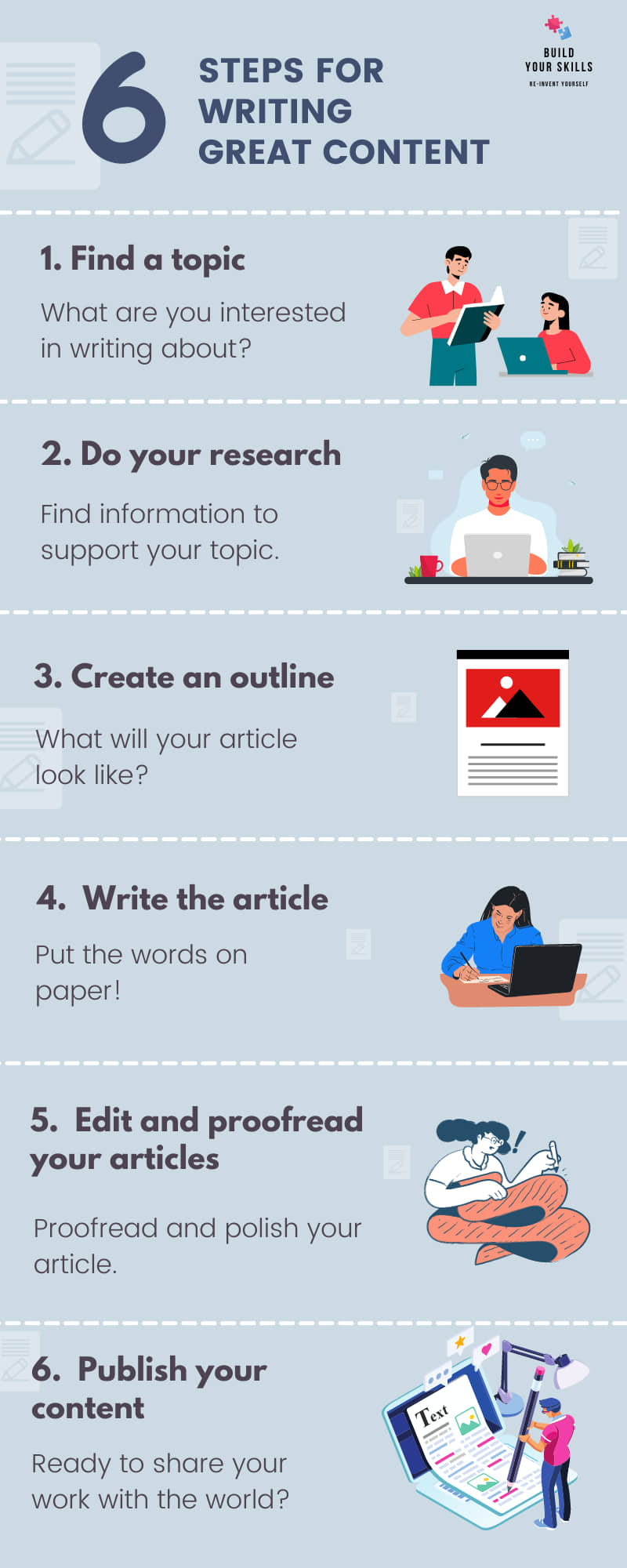
Rules of writing great online content
Writing online content can be a lot of work, but it’s well worth it if you want to be successful. It requires a lot of effort and time and may often seem to be a daunting task if you are new to content writing. However, as you get used to it, you will get immense satisfaction out of creating something that if you were to publish it, people would read and appreciate.
When you are writing content, you will have the opportunity to interact with readers who are interested in your subject and would be willing to engage with you on what you have to offer. Hence, one of the most important things to remember when writing content is to keep the reader in mind always.
The other important thing to keep in mind is that you cannot skip the fundamentals of good writing. The most important thing is the use of clear, simple English. If not, readers may misunderstand your content.
Content writing has a specific set of rules that should be followed to ensure that the content is effective and engaging. Let us go through those now.
Rule 1: Know your audience
When it comes to content writing, one of the most important things to remember is knowing your audience. Without this knowledge, most probably you’ll produce content that doesn’t resonate with your readers and fails to achieve its purpose.
To best understand your audience, consider their needs, interests, and goals. What are they looking for on your website or blog? What can you provide that will help them meet their objectives?
You may also create a buyer persona before writing the content. The purpose of a buyer persona is to identify the buyer’s goals, needs and expectations of the potential buyers of the product or service you sell. Having the buyer persona in hand will make it easy for you to address the needs of your readers/customers directly.
Hubspot has a great guide on buyer persona and a tool for creating one. Check these out for creating the ones for your target customers.
Once you have a good understanding of what your readers want, you can start creating content that meets those needs.
Your writing style should also be tailored to your audience. For example, if you’re targeting business professionals, your tone should be more formal than if you’re targeting teenagers. Keep in mind that there’s no one-size-fits-all approach to writing for different audiences; it’s up to you to determine what works best for you.
Rule 2: Research the topic thoroughly before writing content
When writing content, it is important to do your research so that you are providing accurate information. Failing to do so can result in inaccurate information being spread, which can be harmful to both the writer and the reader. To ensure that you are providing accurate information, it is important to research the topic thoroughly before beginning to write. Additionally, always be sure to verify the sources of your information; don’t trust everything that you read online!
By doing your research and verifying your sources, you can be sure that the content you write is accurate and informative.
One way to determine the credibility of a source is to look at its publishing history. Is the source published by a well-known organization or university? Is it peer-reviewed? If yes, then you can trust the source a lot more.
These are just a few of the factors you should consider when assessing the credibility of a source. You should also look at the author’s qualifications. Does he or she have any expertise in the subject matter? You should also look at the author’s qualifications. Does he or she have any expertise in the subject matter? Another way to verify a source is to compare it with other available sources of information.
By doing your research and verifying your sources, you can be sure that the content you write is accurate and informative.

Rule 3: Create a content outline
One of the most important steps in content writing is creating a clear outline of what you will write. This will help you stay on track and make sure your article or blog post has a clear structure. Here are a few tips for creating a content outline:
1. Start by brainstorming ideas. Jot down everything that comes to mind, even if it doesn’t seem relevant.
2. Group related ideas together.
3. Create a rough outline based on your brainstorming. This doesn’t have to be perfect, just something to help you get started.
4. Think out each point in more detail. Make sure each point is relevant to what you are writing about.
5. Polish your outline until it’s ready for execution.
Rule 4: Make a strong opening statement
The starting sentence or paragraph of your piece of writing is vital to its success. You need to make a strong, impactful statement that grabs the reader’s attention. As per buffer,
55% of Visitors Read Your Articles For 15 Seconds or Less
– Buffer
The opening statement should also give them a clear idea of what you are going to be writing about. You can use the remaining lines in the first paragraph to back up the opening sentence.
For example, “Have you been struggling in a 10-hour job for years and feeling tired? Probably it is time to shift your focus now.” This is an immensely powerful statement because it makes the reader feel motivated to continue reading.
Rule 5: Write with conviction
Do you ever feel like you’re not good enough to do something? That’s how I felt when I first tried content writing. I never thought that I could be a good writer because I wasn’t born into a family of writers. But eventually, I realized that if I wanted to be a good writer, I had to write with conviction and confidence.
Now, I’m not saying that you must sound like a know-it-all or arrogant when you write. But you should believe in yourself and your writing ability. When you write with confidence, your readers will be able to feel it, and they’ll be more likely to stick around until the end.
While writing, put your whole heart into it and do not hold anything back. When you write with conviction, you allow your reader to connect with you on a deeper level. They can feel the passion in your words, and they will be more likely to take your message seriously.
Rule 6: Write in a clear and concise manner
One of the most important skills you can learn in life is how to write effectively. When you can communicate your ideas clearly and concisely, you open a world of possibilities. You can share your thoughts with others, ask for help, or sell your ideas. Writing effectively doesn’t mean writing a lot of words; it means using the right words to say what you mean
Keeping your writing brief is a challenging task, but it’s important to make sure each sentence packs a punch. When you’re editing your work, ask yourself whether each sentence is necessary. If it’s not, cut it out. This will help you keep your writing concise and easy to read.
Rule 7: Use short and snappy sentences
Not only should you make the content concise, but you must also make the sentences short and snappy. There are many reasons for this.
In today’s fast-paced society, people are looking for quick and easy ways to get things done. This is also true for the content they read.
Readers don’t have time to read long, drawn-out paragraphs. They want information that is easy to digest and quickly understood. To keep up with the demands of our readers, we must use short sentences and simple words whenever possible during content writing.

The other reason is that sentences that are too long can be confusing and overwhelming. They can also cause readers to lose interest in what you are saying. By using short, punchy sentences, you can keep your readers engaged and help them understand what you are trying to say.
Finally, short sentences are also more visually appealing than long, run-on sentences. When readers see a wall of text, they are less likely to bother reading it. However, if you use short, punchy sentences, your readers will be more inclined to read your article from beginning to end.
So keep your content brief and engaging, and you’ll hook your readers right from the start. Write in a concise way and get straight to the point without irrelevant details. Brevity is essential when it comes to content writing, where attention spans are notoriously short.
Rule 8: Make the content simple
When people think about writing, they often think about complex sentence structures and difficult vocabulary. However, writing in simple language can be just as effective, if not more so, than complex writing. In fact, by using simple language, you can ensure that your message is clear and easy to understand for your readers.
Additionally, when you do content writing in simple language, you can focus on the message itself rather than on complex sentence structures and vocabulary. As a result, your readers will be more likely to understand and remember your message.
However, while writing certain types of content like technical articles, you may need to use complex language. In those cases, more complex language can add layers of meaning and nuance.
Sometimes, the simplest language is the most effective way to get your point across. Other times, complex language does the job better. The key is knowing when to use each type of language and why.
Rule 9: Use illustrative language
When writing online content, it is important to use illustrative language that will make your readers understand what you are saying better. This means using descriptive words and phrases to help the reader see, feel, touch, smell, and taste what you are describing. When done effectively, illustrative language can bring a piece of writing to life.
For example, imagine that you are describing a beautiful beach. You could say something like, “The sand was soft and white, and the waves were crashing against the shore in a gentle rhythm.” This sentence paints a picture in the reader’s mind of what the beach looks like.
It uses specific details (such as the color of the sand and the sound of the waves) to create a more vivid image.
Another way to use illustrative language is to describe how something feels. For example, you might write, I felt the breeze blowing through my hair as I sat alone on that bench. This sentence uses specific words (such as breeze and hair) to describe what the reader feels. The language used in a piece of writing can help the reader understand better.
Use specific, vivid, and descriptive language during content writing so that you can communicate the features of your products better and capture the interest of your audience faster.
Rule 10: Be specific
Specificity is another major factor that should be considered when doing content writing. It is important to avoid using general language and instead be as specific and clear as possible.
Pouring your heart out into a document or article is great, but if the reader can’t understand what you’re saying, your work will be wasted. The vague and generalized language might make your writing feel more poetic, but in the end, it will only frustrate and confuse your audience.
For example, “I enjoy spending time with my friends” is a very vague statement. It does not tell me exactly how you spend time with them, when you do so or why you like to do so. In contrast, “I like spending time playing cricket with my friends on weekends in the evening” is a much more specific statement. It tells me exactly what I like to do and how.
This kind of specificity makes for much more engaging content. Take the time to ground your thoughts in specific examples, concrete images, and clear arguments.
When you do that, you’ll find that your words carry more weight and your ideas will be easier to communicate.
Rule 11: Make your content interesting
When you’re creating content, it’s important to make it interesting for your readers. This means thinking about what will engage them and capture their attention.
You can do this by focusing on topics that are relevant to them, using interesting visuals, and keeping your writing engaging. Additionally, you can experiment with different formats and styles while doing content writing to find what works best for your audience.
By putting in the effort to create interesting content, you’ll keep your readers engaged and coming back for more. If your content is not worth reading, people will just move on to another website.
Rule 12: Use active voice
When doing content writing for the web, use an active voice to make your words sound more persuasive and engaging. This will help readers understand what you are writing about more easily.
Active voice is more concise and direct than passive voice. When you write in an active voice, the subject of the sentence is doing the action. For example, “The cat sat on the mat” is in an active voice. “The mat was sat on by the cat” is in passive voice. In most cases, you want to use an active voice because it’s more concise and makes your writing more powerful.
In addition to using an active voice, keep your sentences short and to the point. Readers will have less time for distractions, which will help them focus on the content of your post. Use concrete examples, when possible, to illustrate your points and make your post even more informative.
Rule 13: Avoid jargons
Jargon is often used in business and professional settings to make communication more efficient. However, using too much jargon during content writing can have the opposite effect, making communication less clear and alienating potential customers or clients.

To avoid jargon, it’s important to be aware of the words and phrases that are specific to your industry or profession and use them sparingly. You can also try translating jargon into plain English for people who may not be familiar with it.
By avoiding jargon, you’ll make it easier for people to understand what you’re saying and build better relationships with the people you do business with.
Rule 14: Use proven phrases and words
When you are doing content writing use language that will help engage your readers. You can do this by using proven phrases and words that will capture attention and keep the reader interested.
These phrases and words can help you to communicate more effectively, and to get your point across more clearly.
To find these phrases and words, you can research what others have found to be successful in their content or look to resources like thesauruses or word lists.
Once you have a list of words and phrases that interest you, it is important to test them out in your writing to see how they work for you. With a little practice, you can use language that engages your readers and helps improve your content.
Rule 15: Be consistent with your tone and approach
When you’re writing, it’s important to be consistent with your tone and approach. You don’t want to switch from being conversational to formal and back again within the same piece. You also don’t want to sound like a different person in each section.
If you’re going to be funny, be funny throughout. If you’re going to be serious, stay serious. This will help keep your readers engaged and make your content more cohesive. In addition, make sure that your tone remains positive and encouraging throughout your post so that readers don’t get bored or frustrated.
If you can keep all these things in mind during content writing, then you’re on your way to writing quality content that will capture readers’ attention!
Rule 16: Present your ideas logically
When it comes to content writing, many people think that they can just write whatever comes to mind. However, if you want your readers to take you seriously, you need to present your ideas logically. Start by introducing your topic, and then provide evidence or examples to support your argument. Make sure your points are clear and easy to follow and don’t forget to add a conclusion paragraph with a compelling argument.
By presenting your ideas logically, you will be able to write content that is both informative and persuasive.

Rule 17: Make the content scannable
When people read online, they don’t read word-for-word. They scan the content, looking for information that interests them. That’s why it’s important to make your content scannable.
Use short paragraphs, headings, and lists to break up the text and make it easy for readers to find what they’re looking for. You can also use bold or italicized text to highlight key points.
In this way, readers can decide whether they want to read the entire content or only parts of it, and are likely to stay longer in it.
Rule 18: Stick to the facts
It’s no secret that the internet is filled with false information. From bogus health claims to made-up news stories, it can be difficult to determine what’s true and what’s not.
With the rise of “fake news” in recent years, it’s more important than ever to be able to spot these hoaxes and distinguish them from legitimate sources.
One way to do this is to stick to the facts during content writing and fact check your content at the end. Make sure you’re using reputable sources, and if you’re unsure about a claim, do some research before publishing anything.
It may take a little extra time, but it’s worth it for the sake of accuracy. Make sure that all your content is well researched to back up what you write.
Rule 19: Group related ideas together.
To make your content more readable, group related ideas together. This will help your readers follow your train of thought and keep them interested in what you have to say.
By creating a logical structure, you make it easier for them to understand your point of view. Additionally, this technique can also be used during content writing to introduce new topics, as you can provide some background information before delving into the specific details.
There are a few different ways to group related ideas.
- One way is to use bullet points. This is when you list the ideas as separate points with a dot in front of them.
- Another way to group related ideas is by using numbers. You can either list the points one after the other or create a chart with different headings and subheadings.
- Finally, you can also use paragraphs to group related ideas.
Rule 20: Use active and concrete language
Writing great content is essential if you want your blog or article to be read and shared by your target audience.
When doing content writing, use active and concrete language that is easy to understand. This will help keep the reader’s attention focused on your content and hasten the conversion process.
Try to keep your sentences short and to the point, as this will make reading your content a breeze.
And lastly, make sure that all the grammar and spelling in your articles are correct – this will help readers trust you and invest in your writing.
Rule 21: Keep your tone informal but professional
Writing great content is essential if you want to retain readers and convert them into customers or followers. By following these tips, you will be able to produce high-quality content that is both error-free and engaging. Keep your tone informal but still maintain a professional tone so that readers will feel comfortable interacting with you.
Use concrete examples to illustrate your points, which will help readers understand you better. Use active and participatory language to engage readers, making them feel like they are a part of the conversation. And last but not least: always keep in mind the target audience at every step of content writing, whether it is for your blog or articles.
Rule 22: Use catchy headlines
As content marketing becomes increasingly important, it is crucial to write quality articles that will capture the interest of your audience.
To write headlines that grab readers’ attention and compel them to read further, use catchy words and phrases. Make sure your writing is easy to read, without being overly technical or jargonistic.
In addition, make use of keywords in your headline to help search engines index it better. And finally, keep your headline short and to the point – people won’t read any further than the first few words!
Rule 23: Write in an engaging way
Blog writing is all about capturing your readers’ attention and keeping them hooked until the end. By writing in an engaging way, you will be able to capture more traffic and convert more leads into customers. Therefore, start by thinking about what your readers want to know. From there, make sure you are personal and engaging – keep them guessing until the end. Use interesting visuals and catchy phrases to grab their attention and be sure to use accurate information so that they don’t get lost in the blog post. Finally, make sure that your article is well-researched so that you can back up everything you say with solid evidence.
Rule 24: Keep your content updated and relevant
Writing great content is essential for any website or blog, but it becomes even more important when you are marketing your product or service. By keeping your content fresh, updated, and relevant, you will attract more readers and increase the chances of converting them into customers.
To keep your content quality high, make sure to use images and videos sparingly, and always use proper grammar during the entire content writing journey. Additionally, keyword research is essential to help with SEO (search engine optimization). By writing content that is optimized for search engines, you will make sure that your target market can find what they are looking for on your website or blog.
Rule 25: Use keywords in your content
When you’re creating content, it’s important to make sure you include your target keywords. This will help your content rank higher in search engine results pages (SERPs), which means more people will see it and potentially click through to your website.
Keyword research should be done towards the beginning of the content writing process so that you can insert the keyword in the right places while writing the content.
Including keywords doesn’t mean stuffing them into your content wherever they’ll fit; that can actually hurt your ranking. Instead, use them naturally throughout your article, making sure they appear in the title, metadata, body text, and anchor text. You can also use keyword variations and synonyms to help improve your ranking.
However, you should use them sparingly and make sure they are relevant to the content of your page. If you overuse keywords, your site may be penalized by Google’s search algorithm.
When done correctly, including keywords in your content can help boost traffic to your website and increase leads and sales.
Rule 26: Use images and videos to make your articles engaging
Since the early days of the internet, people have been using images and videos to make their articles more engaging. Today, this is more important than ever, as online readers are increasingly distracted by competing content. A well-placed image or video can break up the text and keep readers engaged. It can also help illustrate a point or add interest to a story and make your content more meaningful.

When adding images or videos to your article, be sure to choose ones that are high quality and relevant to the topic. Also, make sure that they are properly credited and linked to their source. If you are using videos, be sure to include a transcript for those who prefer to read rather than watch.
By using images and videos wisely during content writing, you can create an engaging article that will keep readers coming back for more.
Rule 27: Add a call to action and invite comments
Whenever you post any content on the internet, it’s important to include a call to action that invites readers to comment or take some other action like visiting a sales page. This helps to start a conversation with your audience and encourages them to return to your site in the future.
In addition, including a call to action can help you track how well your content is performing by providing you with information on how many people took the time to respond. It can also increase your conversion rates when you write content to generate leads and sales.
Rule 28: Use a content planner to streamline content creation
To create content that is both high quality and effective, it’s important to have a plan. A content planner can help streamline the process by helping you think through your goals and the best way to achieve them. By taking the time to map out your content, you can ensure that each piece is well-crafted and contributes to your overall strategy.
A content planner document is a tool used by content creators to map out their content strategy. It can include things like topic ideas, target audiences, and distribution channels. It comes in especially handy if you are working as a team and multiple people are going to be involved in the content writing process.

In the content planner, you will be able to mark what are the topics you want to write about, when each of those will be published, where those will be published and who will be responsible for writing, editing, and publishing them. This will make your entire content writing process more streamlined.
By taking the time to map out your content, you can ensure that each piece is well-crafted and contributes to your overall strategy.
Top 12 tips from our content writing experts
- Make sure the content is error-free. Thoroughly check for grammatical mistakes, punctuation errors, and spelling mistakes.
- Make sure the content is well-written and well-organized.
- Make sure the tone of the content matches the tone of the website or publication it is being published on.
- Make sure the content is original and not copied (plagiarized) from another source.
- If you are writing a scientific/technical article, then make sure you are using the correct terminologies.
- Break down your points into manageable chunks, making sure each sentence provides valuable information.
- Make sure the content is free from inappropriate and biased language.
- Be aware of the standards and guidelines that are set by your organization or publication for writing about a particular topic or field of study.
- Make sure the content is free from crude or obscene language and references to alcohol, drugs, sex, and violence.
- Ensure that the content is factually correct.
- Always remember to SEO optimize your content.
- Look at your content analytics often to know what type of content is working best for you.
Some popular tools that make content writing easier
Let’s face it, writing content is not a cakewalk for many. Thankfully, there are many popular tools that content writers use to make their lives easier. Here are some of those which you can use to make the content production process easier.
1. Google Docs
This is a word processor that allows you to create and share documents with others. You can easily collaborate on projects with others by sharing the document with them and allowing them to make changes.
2. Evernote
Evernote is a cloud-based note-taking and organizing application. It allows you to create notes in the form of text, images, or web clippings, and then organize them into notebooks. It is a great way to keep track of your ideas and thoughts and also share them with others.
3. Scrivener
Scrivener is a great tool for writers who want to organize their thoughts and ideas before starting to write. It allows you to create different folders for your project, as well as track your progress so you know when you are finished.
4. Grammarly
Grammarly is a great tool for writers who want to catch any grammar mistakes that might slip through the cracks. It uses an algorithm to check your work repeatedly, so you can be sure you are using correct grammar.
5. HubSpot’s Blog Ideas Generator
This is a great tool for writers who want to start brainstorming ideas for blog posts. You can generate topics and then add them to your blog, or you can add them to your Google Drive as an outline so you can write a post later.
6. Google Keyword Planner
Google Keyword Planner is a great tool for writers who want to rank their blog posts on Google. You can enter your target keywords and it will show you how they are related to your topic. It will also show you the search volume, so you know how many people are searching for your keywords.
7. Google Trends
Google Trends is a tool that allows users to see how often particular terms are searched for on Google. The data is presented in the form of a graph, showing how often the term was searched for over a specific period. It can be used to track the popularity of a brand, product, or topic over time.
8. Buzzsumo.com
BuzzSumo is a great tool for finding the most popular posts on other blogs. It will show you which ones are getting the most shares, comments, and likes. You can then use those as your sources when you write your content.
9. Answer The Public
Answer The Public is a website that uses Google’s search engine to find the most typical questions that people are asking about a given topic. It then organizes those questions into a list, which can be used to create content for blogs, articles, and other marketing materials.
10. Canva
Canva is a great site for creating images, blog cover images and infographics. It is extremely easy to use, perfect for those who do not know about graphic design. If you want to make your content more engaging and informative, Canva.com is the place you should go to.
Frequently Asked Questions
What is content writing?
Content writing is the process of creating high-quality, search engine friendly content for a website or blog.
How do you create engaging content?
There are a lot of ways to create engaging content. One way is to use storytelling techniques. Another way is to use social media marketing techniques.
Some tips for creating engaging content include using eye-catching visuals, writing in a clear and concise style, and addressing common objections or questions that people may have about the topic. Additionally, it can be helpful to make sure your content is regularly updated and relevant to current events.
What is the purpose of content writing?
The purpose of content writing is to create compelling and useful content for a website or blog. This content can be used to attract new visitors, engage current visitors, and convert visitors into customers.
Content can be in the form of articles, blog posts, white papers, or even social media posts. The most effective content is well-written, accurate, and engaging.
What are the benefits of content marketing?
There are numerous benefits of content marketing, including improving brand awareness, generating leads and traffic, driving sales, and building a strong relationship with customers.
What are some best practices for structuring your content?
To make sure your content is well-organized and easy to read, follow these best practices:
1. Start with a catchy headline that will grab your reader’s attention.
2. Introduce your topic in the opening paragraph and explain why it’s important.
3. Break up your content into short, easily digestible paragraphs.
4. Use headings and subheadings to highlight key points and organize your ideas.
5. Use images and graphs to illustrate your points.
6. Make sure your content is error-free and well-written.
How do you avoid the common content pitfalls?
The following content tips can help avoid common content pitfalls:
1. Include facts and figures to support your arguments
2. Use strong keywords and search engine friendly phrasing
3. Make sure your writing is easy to read
4. Use clear and concise language
5. Check thoroughly before publishing
What are some techniques for making your content easier to read?
There is no one-size-fits-all answer to this question, as the techniques that work best for one content writer might not be effective for another.
However, some tips for making content easier to read include
1. Breaking down complex information into several easy-to-read paragraphs,
2. Using plain language when writing, and
3. Using images and graphics to break up text and differentiate between different types of information.
What should I include in my blog post?
A blog post should include a headline, body, and conclusion.
The headline is what people will see when they search for your post.
The body is the content of your post.
The conclusion is where you explain what you’ve written.
What are some tips for writing great content?
Content is king when it comes to a website. The site will not be successful if the content is not good. Here are our top tips for writing content that your readers will love!
1. Start with a strong headline that accurately reflects the content of your article.
2. Write in a clear, concise style that’s easy to understand.
3. Make sure your content is well-researched and fact checked.
4. Pay special attention to Grammar, spelling, and punctuation.
5. Use images and videos to break up your text and add visual interest.
6. Engage your readers by asking questions and including call-to-action buttons.
Where do you start when becoming a content writer?
When you first start as a content writer, it can be helpful to look for writing gigs. This way, you can get started and develop your skills without having to spend a lot of time and money upfront.
Additionally, many online publications are looking for new writers all the time, so always keep an eye out for job openings!
How do I develop my own writing style?
When it comes to developing your style, one of the best ways to do this is by reading other well-written pieces and taking inspiration from them.
Try different techniques and genres until you find something that works better for you. And finally, make sure to stay up to date with marketing trends so that your writing style remains current and engaging.
Which sites should I visit if I want to learn about writing for business and marketing purposes?
There are many great resources available to learn about writing for business and marketing purposes, but some of the best include:
1. The Huffington Post
2. Forbes
3. LinkedIn Pulse, and
4. Social Media Explorer.
These sites offer comprehensive information on a variety of topics that can be helpful when it comes to generating content or creating effective campaigns. Additionally, these sites offer tips and advice from experts who have years of experience in the field.
So, whether you’re looking to improve your writing skills or build a strong online presence for your business, visit one of these top-rated websites!
A final word
Content is super important for marketing your business effectively. By writing quality content that is relevant to your target audience, you’ll increase the chances of attracting new customers and boosting SEO. In this blog post, we’ve outlined several types of content that are essential for your business, provided tips on writing quality content, and provided a copywriting guide to help you write content that is both engaging and search engine friendly. So, don’t wait any longer – start writing content today and see the positive effects it has on your business!


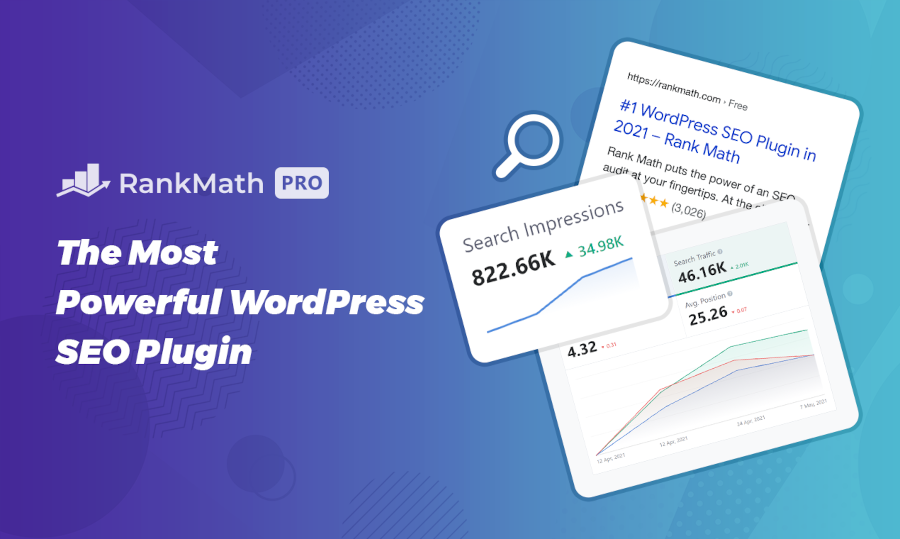






Leave a Reply